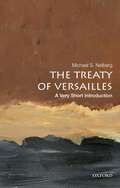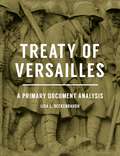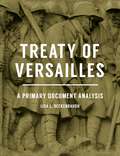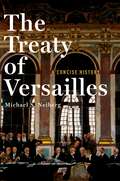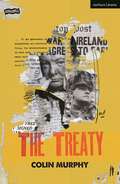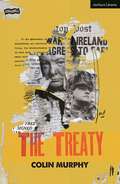- Table View
- List View
Treaty on the Functioning of the European Union - A Commentary: Volume I: Preamble, Articles 1-89 (Springer Commentaries on International and European Law)
by Stelio Mangiameli Hermann-Josef BlankeThe Commentary on the Treaty on the Functioning of the European Union (four volumes) is a major European project that aims to contribute to the development of ever closer conceptual and dogmatic standpoints with regard to the creation of “Europeanised research on Union law”. Following on from the Commentary on the Treaty of the European Union, this book presents detailed explanations, article by article, of all the provisions of the TFEU, discussing the application of Union law in the national legal orders and its interpretation by the Court of Justice of the EU. The authors are academics and practitioners from twenty-eight European states and different legal fields, some from a constitutional law background, others experts in the field of international law and EU law.Reflecting the various approaches to European legal culture, this book promotes a system concept of European Union law toward more unity notwithstanding its rich diversity grounded in national traditions.
The Treaty on European Union (TEU): A Commentary
by Hermann-Josef Blanke and Stelio MangiameliThe major Commentary on the Treaty on European Union (TEU) is a European project that aims to contribute to the development of ever closer conceptual and dogmatic standpoints with regard to the creation of a “Europeanised research on Union law”. This publication in English contains detailed explanations, article by article, on all the provisions of the TEU as well as on several Protocols and Declarations, including the Protocols No 1, 2 and 30 and Declaration No 17, having steady regard to the application of Union law in the national legal orders and its interpretation by the Court of Justice of the EU. The authors of the Commentary are academics from ten European states and different legal fields, some from a constitutional law background, others experts in the field of international law and EU law professionals. This should lead to more unity in European law notwithstanding all the legitimate diversity. The different traditions of constitutional law are reflected and mentioned by name thus striving for a common framework for European constitutional law.
The Treaty of Versailles: A Very Short Introduction (Very Short Introductions)
by Michael S. NeibergSigned on June 28, 1919 between Germany and the principal Allied powers, the Treaty of Versailles formally ended World War I. Problematic from the very beginning, even its contemporaries saw the treaty as a mediocre compromise, creating a precarious order in Europe and abroad and destined to fall short of ensuring lasting peace. At the time, observers read the treaty through competing lenses: a desire for peace after five years of disastrous war, demands for vengeance against Germany, the uncertain future of colonialism, and, most alarmingly, the emerging threat of Bolshevism. A century after its signing, we can look back at how those developments evolved through the twentieth century, evaluating the treaty and its consequences with unprecedented depth of perspective. The author of several award-winning books, Michael S. Neiberg provides a lucid and authoritative account of the Treaty of Versailles, explaining the enormous challenges facing those who tried to put the world back together after the global destruction of the World War I. Rather than assessing winners and losers, this compelling book analyzes the many subtle factors that influenced the treaty and the dominant, at times ambiguous role of the "Big Four" leaders: Woodrow Wilson of the United States, David Lloyd George of Great Britain, Vittorio Emanuele Orlando of Italy, and Georges Clémenceau of France. The Treaty of Versailles was not solely responsible for the catastrophic war that crippled Europe and the world just two decades later, but it played a critical role. As Neiberg reminds us, to understand decolonization, World War II, the Cold War, and even the complex world we inhabit today, there is no better place to begin than with World War I and the treaty that tried, and perhaps failed, to end it. ABOUT THE SERIES: The Very Short Introductions series from Oxford University Press contains hundreds of titles in almost every subject area. These pocket-sized books are the perfect way to get ahead in a new subject quickly. Our expert authors combine facts, analysis, perspective, new ideas, and enthusiasm to make interesting and challenging topics highly readable.
The Treaty of Versailles: A Very Short Introduction (Very Short Introductions)
by Michael S. NeibergSigned on June 28, 1919 between Germany and the principal Allied powers, the Treaty of Versailles formally ended World War I. Problematic from the very beginning, even its contemporaries saw the treaty as a mediocre compromise, creating a precarious order in Europe and abroad and destined to fall short of ensuring lasting peace. At the time, observers read the treaty through competing lenses: a desire for peace after five years of disastrous war, demands for vengeance against Germany, the uncertain future of colonialism, and, most alarmingly, the emerging threat of Bolshevism. A century after its signing, we can look back at how those developments evolved through the twentieth century, evaluating the treaty and its consequences with unprecedented depth of perspective. The author of several award-winning books, Michael S. Neiberg provides a lucid and authoritative account of the Treaty of Versailles, explaining the enormous challenges facing those who tried to put the world back together after the global destruction of the World War I. Rather than assessing winners and losers, this compelling book analyzes the many subtle factors that influenced the treaty and the dominant, at times ambiguous role of the "Big Four" leaders: Woodrow Wilson of the United States, David Lloyd George of Great Britain, Vittorio Emanuele Orlando of Italy, and Georges Clémenceau of France. The Treaty of Versailles was not solely responsible for the catastrophic war that crippled Europe and the world just two decades later, but it played a critical role. As Neiberg reminds us, to understand decolonization, World War II, the Cold War, and even the complex world we inhabit today, there is no better place to begin than with World War I and the treaty that tried, and perhaps failed, to end it. ABOUT THE SERIES: The Very Short Introductions series from Oxford University Press contains hundreds of titles in almost every subject area. These pocket-sized books are the perfect way to get ahead in a new subject quickly. Our expert authors combine facts, analysis, perspective, new ideas, and enthusiasm to make interesting and challenging topics highly readable.
Treaty of Versailles: A Primary Document Analysis
by Lisa L. BeckenbaughAn indispensable resource on the Treaty of Versailles, one of the most influential and controversial documents in history, this book explains how the treaty tried to solve the complex issues that emerged from the destruction of World War I.This carefully curated primary source collection includes roughly 60 documents related to the signing of the Treaty of Versailles. By collecting all of the most significant documents in one volume, it allows readers to hear the original arguments surrounding the treaty and to explore the voices of the people involved at the Paris Peace Conference. Moreover, it allows readers to engage with the documents so as to better understand the complex motivations and issues coming out of World War I and highlights the differences between the victors and identifies the problems many countries had with the treaty before it was even signed.The documents are organized in chronological order, providing a blueprint to help students to understand all of the significant events that led to the treaty, as well as the vast repercussions of the treaty itself. In addition to the Treaty of Versailles itself, documents include such significant primary sources as the Sykes-Picot Agreement, the Balfour Declaration, the Treaty of Brest-Litovsk, President Woodrow Wilson's Fourteen Points, and Germany's response to the treaty.
Treaty of Versailles: A Primary Document Analysis
by Lisa L. BeckenbaughAn indispensable resource on the Treaty of Versailles, one of the most influential and controversial documents in history, this book explains how the treaty tried to solve the complex issues that emerged from the destruction of World War I.This carefully curated primary source collection includes roughly 60 documents related to the signing of the Treaty of Versailles. By collecting all of the most significant documents in one volume, it allows readers to hear the original arguments surrounding the treaty and to explore the voices of the people involved at the Paris Peace Conference. Moreover, it allows readers to engage with the documents so as to better understand the complex motivations and issues coming out of World War I and highlights the differences between the victors and identifies the problems many countries had with the treaty before it was even signed.The documents are organized in chronological order, providing a blueprint to help students to understand all of the significant events that led to the treaty, as well as the vast repercussions of the treaty itself. In addition to the Treaty of Versailles itself, documents include such significant primary sources as the Sykes-Picot Agreement, the Balfour Declaration, the Treaty of Brest-Litovsk, President Woodrow Wilson's Fourteen Points, and Germany's response to the treaty.
The Treaty of Versailles: A Concise History
by Michael S. NeibergSigned on June 28, 1919 between Germany and the principal Allied powers, the Treaty of Versailles formally ended World War I. Problematic from the very beginning, even its contemporaries saw the treaty as a mediocre compromise, creating a precarious order in Europe and abroad and destined to fall short of ensuring lasting peace. At the time, observers read the treaty through competing lenses: a desire for peace after five years of disastrous war, demands for vengeance against Germany, the uncertain future of colonialism, and, most alarmingly, the emerging threat of Bolshevism. A century after its signing, we can look back at how those developments evolved through the twentieth century, evaluating the treaty and its consequences with unprecedented depth of perspective. The author of several award-winning books, Michael S. Neiberg provides a lucid and authoritative account of the Treaty of Versailles, explaining the enormous challenges facing those who tried to put the world back together after the global destruction of the World War I. Rather than assessing winners and losers, this compelling book analyzes the many subtle factors that influenced the treaty and the dominant, at times ambiguous role of the "Big Four" leaders?Woodrow Wilson of the United States, David Lloyd George of Great Britain, Vittorio Emanuele Orlando of Italy, and Georges Clémenceau of France. The Treaty of Versailles was not solely responsible for the catastrophic war that crippled Europe and the world just two decades later, but it played a critical role. As Neiberg reminds us, to understand decolonization, World War II, the Cold War, and even the complex world we inhabit today, there is no better place to begin than with World War I and the treaty that tried, and perhaps failed, to end it.
The Treaty of Versailles: A Concise History (Very Short Introductions Ser.)
by Michael S. NeibergSigned on June 28, 1919 between Germany and the principal Allied powers, the Treaty of Versailles formally ended World War I. Problematic from the very beginning, even its contemporaries saw the treaty as a mediocre compromise, creating a precarious order in Europe and abroad and destined to fall short of ensuring lasting peace. At the time, observers read the treaty through competing lenses: a desire for peace after five years of disastrous war, demands for vengeance against Germany, the uncertain future of colonialism, and, most alarmingly, the emerging threat of Bolshevism. A century after its signing, we can look back at how those developments evolved through the twentieth century, evaluating the treaty and its consequences with unprecedented depth of perspective. The author of several award-winning books, Michael S. Neiberg provides a lucid and authoritative account of the Treaty of Versailles, explaining the enormous challenges facing those who tried to put the world back together after the global destruction of the World War I. Rather than assessing winners and losers, this compelling book analyzes the many subtle factors that influenced the treaty and the dominant, at times ambiguous role of the "Big Four" leaders?Woodrow Wilson of the United States, David Lloyd George of Great Britain, Vittorio Emanuele Orlando of Italy, and Georges Clémenceau of France. The Treaty of Versailles was not solely responsible for the catastrophic war that crippled Europe and the world just two decades later, but it played a critical role. As Neiberg reminds us, to understand decolonization, World War II, the Cold War, and even the complex world we inhabit today, there is no better place to begin than with World War I and the treaty that tried, and perhaps failed, to end it.
The Treaty of Nice and Beyond: Enlargement and Constitutional Reform (Essays in European Law)
by Mads Andenas John UsherDesigned to succeed previous books on the Maastricht and Amsterdam treaties,this new work includes contributions from leading EU lawyers assessing the Nice Treaty and the Post-Nice process, which is rapidly developing in the lead-up to the next Intergovernmental conference. The book's central theme is the discussion of a European Constitution and European Constitutionalism. The new constitutional balance after institutional reform, the Luxembourg courts after Nice, the future of the three pillar Treaty structure and the Human Rights charter are the other main topics. Among the contributors are the editors, Professor Stephen Weatherill (Oxford), Professor Noreen Burrows (Glasgow), Professor Jürgen Schwarze (Freiburg), Professor Paul Craig (Oxford), Professor Jo Shaw (Manchester) Steve Peers (Essex) Professor Piet Eeckhout (King's College, London) and Professor Alan Dashwood (Cambridge).
The Treaty of Lisbon: Origins and Negotiation (Palgrave Studies in European Union Politics)
by D. PhinnemoreDetailed and comprehensive analysis of how the Treaty of Lisbon emerged in 2007 this book explores the role played by the German Council Presidency and the EU's institutional actors in securing agreement among the leaders of member states on an intergovernmental conference as well as a new treaty text to replace the rejected Constitutional Treaty.
The Treaty of Amsterdam: Facts, Analysis, Prospects (Europainstitut Wirtschaftsuniversität Wien Schriftenreihe Europainstitut Wirtschaftsuniversität Wien Publication Series #15)
by Stefan Griller Dimitri P. Droutsas Gerda Falkner Katrin Forgo Michael NentwichThe Treaty of Amsterdam has introduced important changes into the constitution of the European Union, for example, in the fields of internal and external affairs and employment policy, which will impact upon the future of the Union. Also of considerable importance is the new option to establish closer co-operation between a group of Member States, as well as certain institutional modifications. Particular attention is paid to areas of the Treaty of Amsterdam which are unclear or apparently deficient. All of these topics are of greatest importance within the course of the ongoing thematic debate, not the least on future EU-enlargement. The book is addressed to experts and anyone interested in European affairs.
The treaty-making power in the Commonwealth of Australia
by Günther DoekerIn the relation of states, treaties are a matter of great importance. The law of treaties and the study of treaty-making procedures in municipal law systems have become both from a theoretical and practical point of view, subjects of increasing interest. The United Nations Legal Committee as well as the International Law Commission have published studies concerned with the relationship of international law and municipal law, emphasizing national practices concerning the conclusion of treaties. In the case of some countries, such as Great Britain and the United States, numerous studies of treaty making problems have been made, but much less has been published in the case of many other countries such as Australia, Canada or India. In the case of Australia, research on treaty-making has resulted in comparatively few published articles in scholarly and legal journals and only a few comments in general legal treatises. But no comprehen sive legal analysis of the subject has as yet appeared. This study aims to present a comprehensive survey and analysis of actual treaty making procedures and practices in Australia against the setting of the relevant constitutional and other legal norms of the Australian political system. The analysis of treaty-making will consider both normative and empirical legal aspects. Basic constitutional norms, legal principles derived from common and constitutional law and statutes will be discussed, as well as the actual practices and procedures used in the exercise of the treaty-making power.
Treaty Interpretation Under the Vienna Convention on the Law of Treaties: A New Round of Codification
by Chang-Fa LoThis book is devoted to an idea of a second round of codification of certain new rules for treaty interpretation. Currently, treaty interpretation is guided by Articles 31 through 33 of the Vienna Convention on the Law of Treaties (VCLT). The fundamental rule is that a treaty shall be interpreted in good faith in accordance with the ordinary meaning to be given to the terms of the treaty in their context and in the light of its object and purpose. These rules lay the foundation for treaty interpretation. They represent the first round of codification of the contents of some previous customary international law rules. The book argues that the current rules are overly simplified. After almost fifty years of codification of the VCLT, the codified text in it is practically insufficient in addressing some traditional treaty interpretation issues (such as the interpretation involving time factors or technology development) and in coping with some new development of international law (such as the diversification and fragmentation of international treaties) and new challenges (such as the need of coordination between different treaties and the need of introducing external values, including human rights, into a treaty through treaty interpretation process). The book further argues that there is a need to have a second round of codification so as to incorporate new rules into the VCLT to be followed by treaty interpreters to make treaty interpretation more consistent and transparent, and more in line with the shared value of international community. The book proposes the contents of certain new rules to be considered as the new codified rules for treaty interpretation.
Treaty Interpretation (Oxford International Law Library)
by Richard GardinerThis series features works on substantial topics in international law which provide authoritative statements of the chosen areas. Taken together they map out the whole of international law in a set of scholarly reference works and treatises intended to be of use to scholars, practitioners, and students. This book provides a guide to interpreting treaties properly in accordance with the modern rules for treaty interpretation which are codified in the Vienna Convention on the Law of Treaties. These rules now apply to virtually all treaties both in an international context and within many national legal systems where treaties have an impact on a large and growing range of matters. Lawyers, administrators, diplomats, and officials at international organisations are increasingly likely to encounter issues of treaty interpretation which require not only knowledge of the relevant rules but also how these rules have been, and are to be, applied in practice. There is now a considerable body of case law on application of the codified rules. This case law, combined with the history and analysis of the rules, provides a basis for understanding this most important task in the application of treaties internationally and within national systems of law. Any lawyer who ever has to consider international matters, and increasingly any lawyer whose work involves domestic legislation with any international connection, is at risk nowadays of encountering a treaty provision which requires interpretation, whether the treaty provision is explicitly in issue or is the source of the relevant legislation. This expanded edition includes consideration of a range of recent cases, takes account of relevant work of the International Law Commission, and has new material addressing matters raised in the growing body of literature on treaty interpretation.
The Treaty (Modern Plays)
by Colin MurphyIn October 1921, a delegation of the Dáil left by boat and train for London, where they were to negotiate with the British government for peace, unity and a republic. They came back with just one of those; and that peace didn't last long, as war with Britain was replaced by war with their own. Were the Irish outclassed or outgunned? Were they lied to? Did they lie to their own colleagues back in Dublin? Or did they achieve the best that could be achieved, an incremental step on the way to fuller sovereignty? The Treaty tells the story of what happened inside those negotiations, as Arthur Griffith, Michael Collins and colleagues faced off against one of the most formidable negotiating teams ever assembled, headed by David Lloyd George and with Winston Churchill often at his side. This edition is published to coincide with Fishamble's production in November 2021.
The Treaty (Modern Plays)
by Colin MurphyIn October 1921, a delegation of the Dáil left by boat and train for London, where they were to negotiate with the British government for peace, unity and a republic. They came back with just one of those; and that peace didn't last long, as war with Britain was replaced by war with their own. Were the Irish outclassed or outgunned? Were they lied to? Did they lie to their own colleagues back in Dublin? Or did they achieve the best that could be achieved, an incremental step on the way to fuller sovereignty? The Treaty tells the story of what happened inside those negotiations, as Arthur Griffith, Michael Collins and colleagues faced off against one of the most formidable negotiating teams ever assembled, headed by David Lloyd George and with Winston Churchill often at his side. This edition is published to coincide with Fishamble's production in November 2021.
Treats: Treats
by Christopher HamptonWhile her bullying and unfaithful boyfriend, Dave, is reporting in Iraq, Ann seizes the opportunity to change the locks and take up with her infinitely more considerate colleague Patrick. But Patrick proves no match against savagery and charisma when Dave comes crashing home, determined to win back his girl.First staged at the Royal Court Theatre, London, in 1976, this updated version demonstrates that, in love, our instinct for making the wrong decisions remains as sharp as ever. Treats was revived at the Garrick Theatre, London, in February 2007, following a tour to Windsor, Malvern, Bath and Richmond.
Treatments for Skin of Color E-Book
by Susan C. Taylor Raechele C. Gathers Valerie D. Callender David A. Rodriguez Sonia Badreshia-BansalWritten to address conditions specifically associated with ethnic disparities in skin types, Treatments for Skin of Color, by Susan C. Taylor, Sonia Badreshia, Valerie D. Callender, Raechele Cochran Gathers and David A. Rodriguez helps you effectively diagnose and treat a wide-range of skin conditions found in non-white patients. Presented in an easy-to-use, templated format, this new reference encompasses medical dermatology and cosmetic procedures and provides you with evidence-based first and second line treatment options. Practical tips and other highlighted considerations minimize the risk of potential pitfalls. A dedicated section examines alternative therapies, some of which have cultural significance and may impact medical outcomes. An abundance of vivid color images and photos provide unmatched visual guidance for accurate diagnosis and treatment. Get information not found in mainstream dermatology references. Essential medical dermatology and cosmetic procedures as well as evidence-based first and second line treatment options provide you with specific information to treat a full range of conditions found in skin of color. Offer your patients the best care and avoid pitfalls. Evidence-based findings and practical tips equip you with the knowledge you need to recommend and discuss the most effective treatment options with your patients. Broaden your understanding of complementary and alternative medicine (CAM) used by your patients. A special section examines the cultural significance and impact on medical outcomes caused by these alternative therapies. Spend less time searching with easy-to-use, templated chapters focused on visual identification and diagnosis of diseases across all skin tones, and recommended treatment options. Make rapid, confident decisions on diagnosis and treatment by comparing your clinical findings to the book’s extensive collection of 270 detailed illustrations.
Treatments for Psychological Problems and Syndromes
by Dean McKay Jonathan S. Abramowitz Eric A. StorchAn important new guide to flexible empirically supported practice in CBT. There is a growing movement across health care to adopt empirically supported practice. Treatments for Psychological Problems and Syndromes makes an important contribution by offering a comprehensive guide for adopting a more flexible approach to cognitive behavioural therapy. Edited by three recognized experts in the field of CBT, the text has three key aims: firstly to identify components of models describing specific psychological conditions that are empirically supported, poorly supported or unsupported; secondly to propose theoretical rationales for sequencing of interventions, and criteria for moving from one treatment procedure to the next; and thirdly to identify mechanisms of psychological syndromes that may interfere with established protocols in order to promote more informed treatment and improve outcomes. Written in clear and concise terms, this is an authoritative guide that will be relevant and useful to a wide range of readers from beginning clinicians to experienced practitioners.
Treatments for Psychological Problems and Syndromes
by Dean McKay Jonathan S. Abramowitz Eric A. StorchAn important new guide to flexible empirically supported practice in CBT. There is a growing movement across health care to adopt empirically supported practice. Treatments for Psychological Problems and Syndromes makes an important contribution by offering a comprehensive guide for adopting a more flexible approach to cognitive behavioural therapy. Edited by three recognized experts in the field of CBT, the text has three key aims: firstly to identify components of models describing specific psychological conditions that are empirically supported, poorly supported or unsupported; secondly to propose theoretical rationales for sequencing of interventions, and criteria for moving from one treatment procedure to the next; and thirdly to identify mechanisms of psychological syndromes that may interfere with established protocols in order to promote more informed treatment and improve outcomes. Written in clear and concise terms, this is an authoritative guide that will be relevant and useful to a wide range of readers from beginning clinicians to experienced practitioners.
Treatments for Anger in Specific Populations: Theory, Application, and Outcome
by Ephrem FernandezThe last several years have seen a significant increase in research on anger and its clinical treatment. As a result, anger management has become the topic of many self-help books, but there is currently no book that brings together for practitioners and scholars the diversity of therapies used to treat anger in various populations. Treatments for Anger in Specific Populations provides information and instruction on empirically supported interventions for anger in various clinical contexts, including substance abuse, PTSD, the intellectually disabled, borderline personality disorder, children and adolescents, and others. Ten chapters focus on specific populations, while two additional chapters discuss gender and culturally sensitive considerations in anger treatment. An introductory chapter by the volume editor, Ephrem Fernandez, outlines the main therapeutic approaches to anger, summarizing the boundaries between adaptive and maladaptive anger and providing a rationale for tailoring anger treatments to specific populations. For each population-specific chapter, authors provide theoretical background and literature review, followed by findings on the efficacy of each treatment. Each treatment evaluated is also clearly described in terms of clinical procedure. Further, each chapter contains a clinical case vignette illustrating the application of particular treatments to particular clients. Where appropriate, discussions of emerging and as-yet untested therapies are included. Treatments for Anger in Specific Populations is a resource to be treasured by clinicians who work regularly with anger problems and anger disorders, and the volume's careful balance of research review with important information about treatment application will also render it useful to scientists interested in anger.
Treatment–Refractory Schizophrenia: A Clinical Conundrum
by Peter F. Buckley Fiona GaughranSchizophrenia is often associated with an inadequate response to pharmacological and non-pharmacological treatments. How to treat patients who have an unsatisfactory response to anti-psychotics, including clozapine - which is unequivocally the most powerful antipsychotic medication for this recalcitrant population - remains a clinical conundrum. A range of adjunctive medications have been tried with mixed results; there has also been renewed interest in the role of neuromodulatory strategies, electroconvulsive therapy, and cognitive and vocational approaches. Perhaps a bright spot for the future lies in the evolution of pharmacogenetic approaches for individualized care.In this book, leading experts from Europe, Australia and the Americas provide a timely appraisal of treatments for the most severely ill schizophrenia patients. This clinically focused book is informed by the latest research on the neurobiology and treatment of schizophrenia. It is comprehensive in scope, covering current treatment options, various add-on approaches, and a range of psychosocial treatments. The contributors are respected experts who have combined their clinical experience with cutting-edge research to provide readers with authoritative information on fundamental aspects of clinical care for schizophrenia.
Treatment Without Consent: Law, Psychiatry And The Treatment Of Mentally Disordered People Since 1845
by Phil FennellPhil Fennell's tightly argued study traces the history of treatment of mental disorder in Britain over the last 150 years. He focuses specifically on treatment of mental disorder without consent within psychiatric practice, and on the legal position which has allowed it. Treatment Without Consent examines many controversial areas: the use of high-strength drugs and Electro Convulsive Therapy, physical restraint and the vexed issue of the sterilisation of people with learning disabilities. Changing notions of consent are discussed, from the common perception that relatives are able to consent on behalf of the patient, to present-day statutory and common law rules, and recent Law Commission recommendations. This work brings a complex and intriguing area to life; it includes a table of legal sources and an extensive bibliography. It is essential reading for historians, lawyers and all those who are interested in the treatment of mental disorder.
Treatment Without Consent: Law, Psychiatry And The Treatment Of Mentally Disordered People Since 1845
by Phil FennellPhil Fennell's tightly argued study traces the history of treatment of mental disorder in Britain over the last 150 years. He focuses specifically on treatment of mental disorder without consent within psychiatric practice, and on the legal position which has allowed it. Treatment Without Consent examines many controversial areas: the use of high-strength drugs and Electro Convulsive Therapy, physical restraint and the vexed issue of the sterilisation of people with learning disabilities. Changing notions of consent are discussed, from the common perception that relatives are able to consent on behalf of the patient, to present-day statutory and common law rules, and recent Law Commission recommendations. This work brings a complex and intriguing area to life; it includes a table of legal sources and an extensive bibliography. It is essential reading for historians, lawyers and all those who are interested in the treatment of mental disorder.


